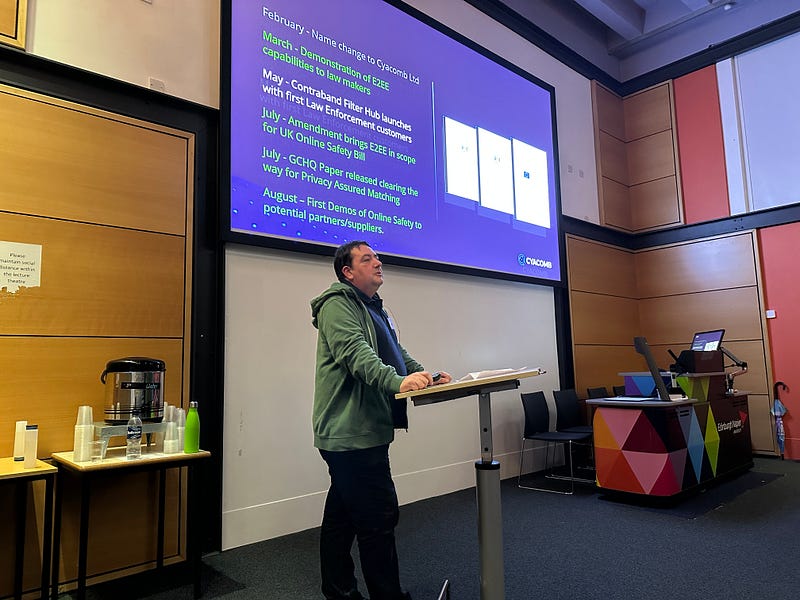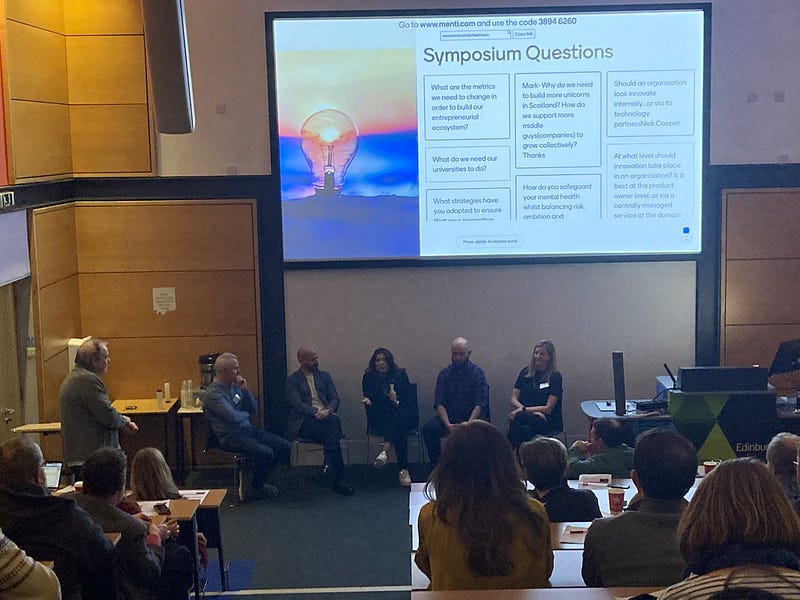Innovation, Innovation, Innovation

Innovation, Innovation, Innovation: Building Bridges and Towards the Enterprise Campus
“We’re here to put a dent in the universe. Otherwise why else even be here?” — Steve Jobs
We hosted an excellent symposium yesterday on technology innovation and collaboration, and it was one of our first live events after the lockdown period. And, so we carefully picked the speakers for a balance of future gazing, some great successes, and in finding opportunities for funding. And, after months of planning, we were all ready to go:

Opening and finding funding
It has been an exciting time for us at Edinburgh Napier University, as our schools of Computing, and Engineering and the Built Environment have merged. This has been done under the leadership of our new Dean (Professor Peter Andras), so it was a natural start to the event to have Peter open it:

For our innovation, it was over to Nick Fannin to set the scene for the event:

And then onto Linda Wallace to set the scene in Scotland, and outline the drive for innovation, and with the launch of our new Innovation Hub [here]:

Innovate UK has funded KTP (Knowledge Transfer Partnerships) for over 40 years, and they are one of the most successful programmes to link industry with academia. It was then over to Judy Brown (who leads the East of Scotland KTP Centre) to outline its operation [here]:

Next up in our funding stream was Howell Davies from Interface Online, and who outlined their mechanisms for enabling collaboration between industry and academia [here]:

And, one of the true successes in Scotland, has been the support from Scottish Enterprise within the HGSP (High Growth Spin-out Programme). This scheme allows the support for potential spin-out companies to develop a strong business case, and move towards funding. All of our successful spin-outs have received this support, and it strengthened every one of them. This allows us to find an executive team to drive the spin-out forward, while also matching the research work to industry problems. And, so, Frank Tooley, outlined the programme at the event:

At the core of academic research is UKRI and for engineering and physical sciences, the main research council is EPSRC. Alex Peden then outlined the extensive range of funding schemes that are currently supported by EPSRC, and also highlighted the importance of impact with research. This highlighted the advancement of knowledge (eg new tools and techniques), social impacts (eg policy, regulations and standards), impacts on people (eg career progress), and an impact of the economy (eg job creation). For Alex, the great the impact, the more that EPSRC can support its research base [here]:

And to end the last session, it was the inspiration of Fiona Masson. For Fiona, the future is all about building bridges between industry and academia, and in driving partnerships:

Research Journeys
We were then off to lunch, and then back with some examples of research journeys, and a natural place to start was with Pavlos Papadopoulos (our Young Cyber Person of the Year). Over the past three years, Pavlos has developed his research related to distributed ledgers, and this shows create potential in a number of areas. For Pavlos the focus has been on an application into the software supply chain, and thus to create more trustworthy software [here]:

A key part of innovation is the support and guidance from a business point-of-view. For this, we are so lucky to have Nanik Ramchandani supporting both of our forthcoming spin-outs (True Deploy and LastingAsset). He hosted the session, and guided us through stories of how research leads to impact:

And, if you know anything about the great spin-out work that is conducted in the university, you’ll know about the leadership and drive from Nick Fannin. In this presentation, Nick outlined the opportunities for start-ups and the support from universities, and especially highlighted the work within the Munich Accelerator:

And, so it was onto stories of success, and a natural place to start was Jamie Gravies, and who led our first spin-out (Zonefox) to success. For Jamie, the journey was a bumpy one and all about grabbing opportunities when they occurred. Along with this, his advice was not to build a fully defined product but to be agile for its applications into use cases. He also outlined how difficult it can be to scale from a pilot implementation to a production-ready environment. Zonefox was acquired by Fortinet, and it all stemmed from Jamie’s drive for improved methods of creating and handling digital forensics data:

And, if there’s one person, I would recommend transforming health care with digital technologies, it is Chaloner Chute [here]. To me, no one on the planet understands more about how we can create more citizen-focused healthcare systems. For him, it is the driving force of “To tell my story once”, “Meaningful dialogue with professionals”, “To access and understand my data and guidance”, “To do things on my own terms”, and “To unlock or unblock the care I need”. All simple things that citizens understand, but where Chal breaks these down into technology solutions, that do indeed build bridges between the citizen and our healthcare infrastructure. To me, truly, truly, truly inspirational, and I have faith in the future of our healthcare infrastructure in Scotland with people like Chal around. As you may know, technological innovation in health care is one of the most difficult areas, but Chal does it so well:

From Idea to Impact
For our final session, it was all about gazing into the future, and where Kendra Byers introduced us to areas of innovation in cybersecurity and around FinTech industry:

And, for inspiration and a route for companies striving to scale their market, we turn to Bruce Ramsay the technical and scientific lead from Cyacomb (our third university spin-out). For Bruce, the bump in the road was a complete refocus and redraft of a business plan. From an application towards data loss prevention, Ian Stevenson (the CEO at Cyacomb) refocused on the spin-out on their core market: law enforcement. And, has worked like a dream, with Cyacomb advancing in international markets, and taking advantage of opportunities [here]. And, for Bruce, a key focus has been continuing to develop new innovative areas, and have a pipeline of innovation:

And, FinTech is one of the most disruptive spaces for innovation. Dia Banerji (a UK Ambassador for Women In Identity and Ambassador of Women’s Enterprise Scotland) [here][here] then outlined the spaces where maximum disrupt about occurs, and that we need to move from a focus on features and products towards outcomes:

And, always someone to listen to every word, we had Federico Charosky from Quorum Cyber. A core message from his was to get the team right, and partner with those who can drive the business forward not just for now, but for when the business grows in the future. And for Federico, he saw the opportunity of using Microsoft’s cybersecurity tools, while others in the industry looked elsewhere, and it was a genius decision:

And, with our panel (Fiona, Mark, Federico, Dia, and Jamie) could have gone on for hours, as it was so interesting. In there we debated, the gender balance within our innovation infrastructure, and how we can best support a scale-up of innovation:

Keynote talk: Mark Logan
And, so, to end, of course, we turned to Mark Logan, and his drive to see enterprise as a core part of university life: The Enterprise Campus. He outlined that we faced many exponential increases in many areas, such as climate change. With a focused approach to innovation, we need an exponential decay in terms of the costs of the tools that we need to address these, and if we can find the balance, we can hopefully catch these in time. For him, research is only part of the work that universities can do, and then need to get focused on innovation as a larger ecosystem that takes ideas and translates them into products that address fundamental issues in our society:

And for Mark:
real innovation happens in the gaps between disciplines
and that:
innovation isn’t just research, but invention and scale.
And, along the way, we networked and discussed and planned collaborations:





























Conclusions
We must address the fundamental issues in our society, and innovation provides a core part of this. This is not a journey for one person to lead but involves many hands working together. Let’s build the future … go innovate!